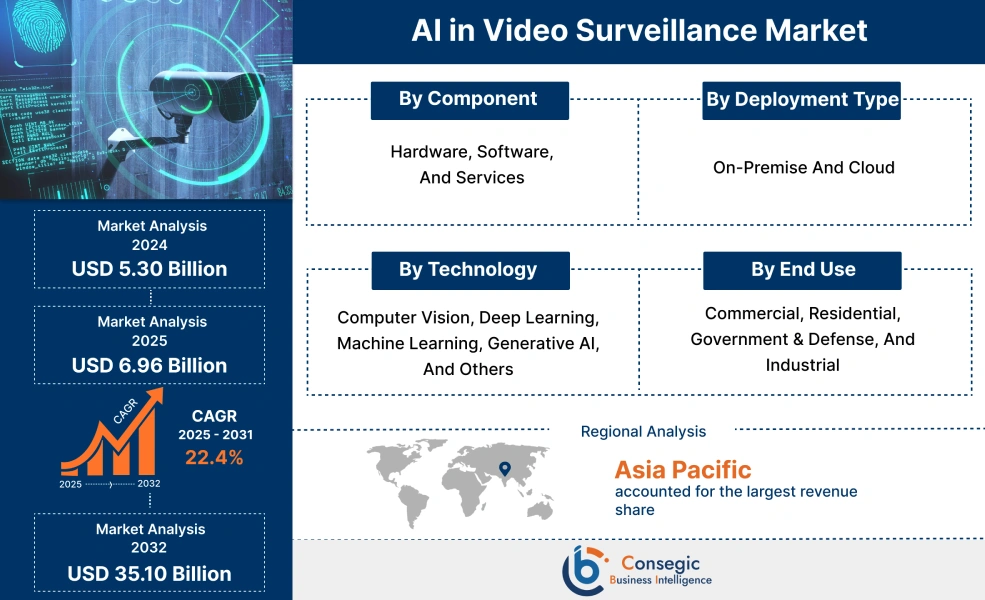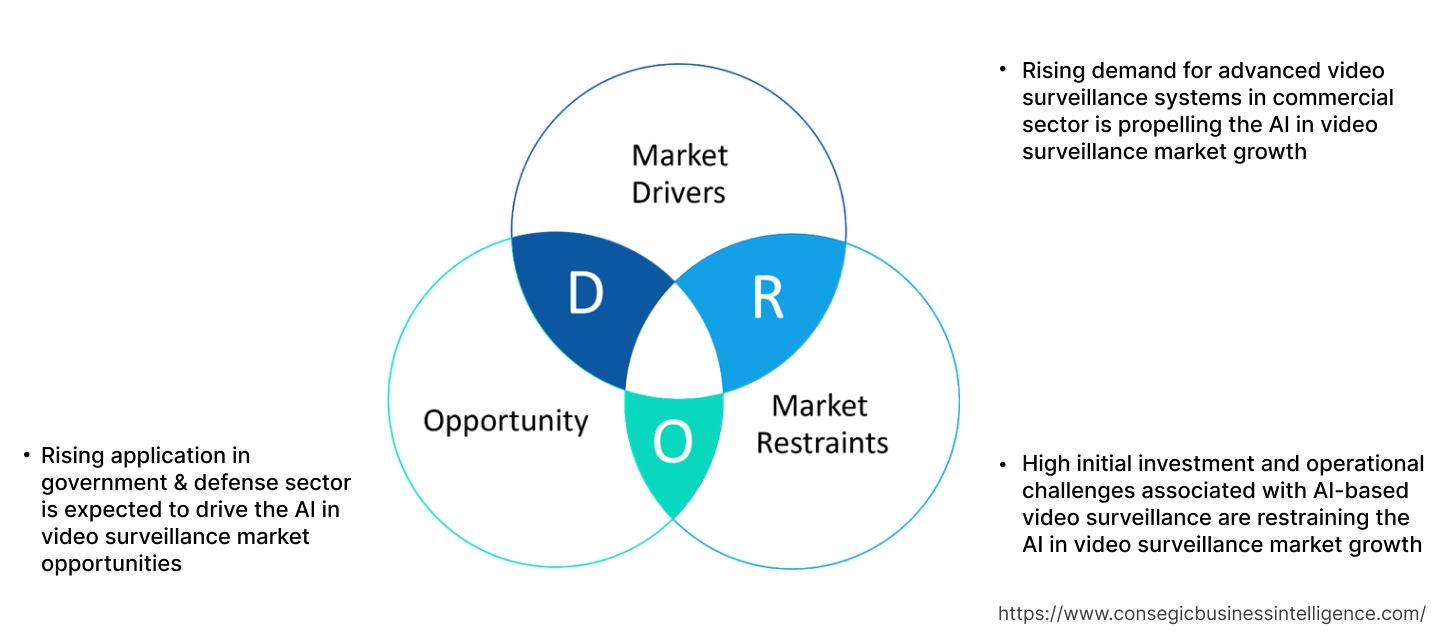AI in Video Surveillance Market Size:
AI in Video Surveillance Market size is estimated to reach over USD 35.10 Billion by 2032 from a value of USD 5.30 Billion in 2024 and is projected to grow by USD 6.96 Billion in 2025, growing at a CAGR of 22.4% from 2025 to 2032.
AI in Video Surveillance Market Scope & Overview:
The integration of AI in video surveillance has significantly transformed the field of video surveillance by improving the capabilities and effectiveness of security and monitoring systems. AI-based video surveillance is used for several applications including object detection and recognition, facial recognition, behavioral analysis, automated monitoring, and others. Moreover, the integration of AI in video surveillance offers several benefits such as enhanced security, minimized risks of human errors, real-time alerts and response, increased operational efficiency, and others. Additionally, the above benefits of AI-based video surveillance are further increasing its deployment in commercial, residential, government & public sector, military & defense, and industrial sectors.
AI in Video Surveillance Market Dynamics - (DRO) :
Key Drivers:
Rising demand for advanced video surveillance systems in commercial sector is propelling the AI in video surveillance market growth
AI-based video surveillance plays a crucial role in the commercial sector, including retail, banking, healthcare, and others for real-time monitoring and surveillance applications. Moreover, the utilization of AI-based video surveillance in retail sector enables retailers to optimize store layouts and product placements by tracking customer’s journeys, evaluating routes, and detecting walking patterns. Similarly, AI-based video surveillance help retailers in monitoring product stock levels in real-time, restocking products based on demand while preventing out-of-stock situations, and maximizing sales. Additionally, AI-based video surveillance plays a significant role in improving the overall security of retail stores by leveraging intelligent video surveillance monitoring and reducing the risk of theft and losses.
Further, AI-based video surveillance system is often utilized in banking firms for monitoring all their branches and ATM locations remotely around the clock. AI-based video surveillance systems help banking firms increase safety and situational awareness by leveraging their existing surveillance networks to monitor and respond to events as well as search and filter videos for accelerating post-event investigations.
- For instance, in September 2023, Ralph Lauren Corporation launched its first retail store in Canada, as a part of the company’s expansion strategy. The store is located in Yorkdale Shopping Centre in Toronto and adds to the brand’s existing outlet presence in the country. The corporation has 12 Ralph Lauren outlet stores in Canada along with wholesale presence at retailers including Harry Rosen, Hudson’s Bay, and others.
Hence, the growing need for advanced video surveillance systems in the commercial sector, including retail, banking, healthcare, and others, is driving the AI in video surveillance market size.
Key Restraints:
High initial investment and operational challenges associated with AI-based video surveillance are restraining the AI in video surveillance market growth
The implementation of AI-based video surveillance is often associated with certain operational limitations and challenges, which are among the key factors restraining the market. For instance, AI-based video surveillance is often associated with high initial investment and implementation costs. The system also requires additional ongoing costs related to maintaining and upgrading the system hardware and software, as well as training employees for its effective utilization. Moreover, AI-based video surveillance can be quite complex and challenging to implement, particularly for small businesses with limited IT and financial resources as the software usually requires a certain degree of customization and integration with existing systems, which can be costly and time-consuming.
Additionally, data privacy concern is a significant limitation in AI-based video surveillance systems, specifically when dealing with personally identifiable data or sensitive information. Further, the deployment of cloud-based video surveillance system is usually associated with a higher risk of security threats including cyberattacks, data breaches, and privacy disclosures as most of the data including sensitive information is stored and processed on the cloud, which makes the system highly susceptible to cyber attackers and hackers. Thus, the aforementioned factors are hindering the AI in video surveillance market expansion.
Future Opportunities :
Rising application in government & defense sector is expected to drive the AI in video surveillance market opportunities
AI-based video surveillance systems have been transforming the manner in which government and defense agencies monitor public spaces, respond to critical situations and emergencies, and secure infrastructure. The integration of AI in video surveillance systems enables government agencies to obtain valuable information from the surveillance footage, undertake data-driven decisions, and drive impactful results. Moreover, the utilization of AI-based video surveillance systems enables government and defense personnel to commence proactive threat detection, and swift response to critical situations and emergencies. Additionally, the integration of AI-based video surveillance systems in the government and defense sector provides several benefits including improved public safety, efficient resource management, preventive action against possible incidents, and facilitation of extensive perimeter surveillance among others.
- For instance, according to the European Defense Agency, the general budget for the European Defence Agency was valued at USD 54,095.5 million in 2024, witnessing an increase of 11.1% in comparison to USD 48,704.4 million in 2023.
Hence, the rising investments in the government & defense sector are projected to increase the adoption of AI-based video surveillance systems, in turn driving the AI in video surveillance market opportunities during the forecast period.
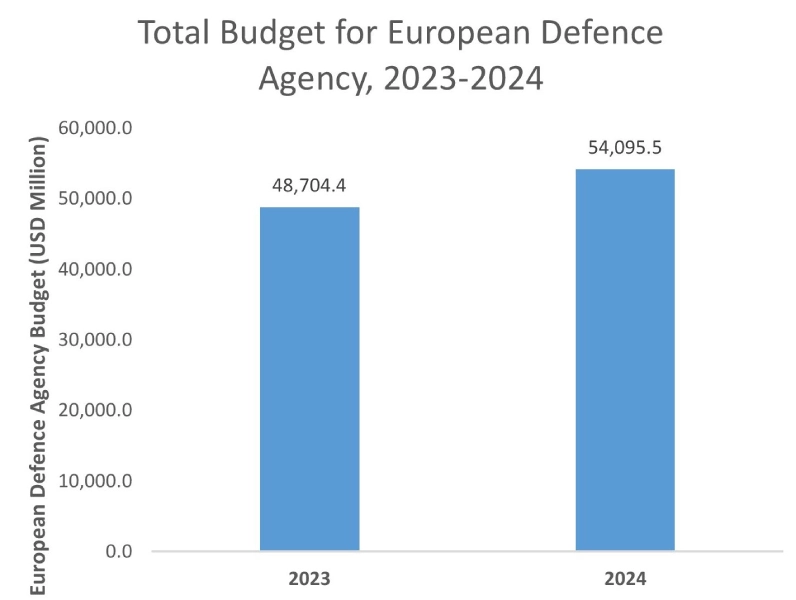
AI in Video Surveillance Market Segmental Analysis :
By Component:
Based on component, the market is segmented into hardware, software, and services.
Trends in the component:
- Increasing technological advancements associated with hardware devices such as cameras, storage systems, networking equipment, and others used in AI-based video surveillance solutions.
- Rising trend towards utilization of AI-based video surveillance software for monitoring, analyzing, and managing large volumes of video for facilitating improved decision-making and increasing operational efficiency.
The hardware segment accounted for the largest revenue share of 55.92% in the total AI in video surveillance market share in 2024.
- Hardware segment AI-based video surveillance systems primarily include cameras, storage systems, networking devices, and others.
- Cameras play a major role in AI-based video surveillance for transmitting and receiving data over a network. They are often equipped with higher resolutions, superior image sensors, and advanced processing capabilities.
- For instance, in September 2023, Teledyne FLIR launched its new FLIR FC-Series AI model of thermal camera for video surveillance applications among others. The camera is integrated with AI analytics that can precisely classify vehicles and humans for early intrusion detection for perimeter protection and remote site monitoring.
- Therefore, the rising advancements associated with hardware devices used in AI-based video surveillance systems are further driving the AI in video surveillance market trends.
Software segment is anticipated to register the fastest CAGR growth during the forecast period.
- The software segment includes machine learning and advanced AI algorithms for monitoring, analyzing, and managing large volumes of video.
- AI-based video surveillance software is capable of digitally analyzing video inputs, transforming them into intelligent data which further helps in decision-making.
- Moreover, AI-based video surveillance software offers a range of benefits including in-depth analysis, object recognition and motion detection, automated real-time video surveillance, along with notifications and alerts in case of security breaches among others.
- For instance, NEC Corporation offers intelligent AI-based video surveillance software that uses AI and computer vision for extracting relevant insights from video streams, which enables data-driven decisions and optimized operations. The software facilitates real-time monitoring and analysis of several parameters such as crowd patterns, customer behavior, queue management, and others for improving operational efficiency.
- Hence, the above factors are expected to boost the market during the forecast period.
By Deployment Type:
Based on deployment type, the market is segmented into on-premise and cloud.
Trends in the deployment type:
- The adoption of on-premise deployment is primarily driven by factors including higher security and privacy, and more control over server hardware.
- Factors including the ease of integration, rapid deployment, and increasing consumer preference for flexible, scalable, reliable, and cost-effective AI-based video surveillance solutions are key trends driving the cloud deployment segment.
On-premise segment accounted for a substantial revenue in the total AI in video surveillance market share in 2024.
- An on-premise deployment indicates that computers used for processing video analytics are deployed on-site, whether it is in the form of smart cameras or a GPU server.
- On-premise deployment enables enterprises to manage and have complete control over its integrations and maintain tighter control over the system’s security aspects as compared to cloud-based deployment.
- Factors including higher security and privacy, lower network bandwidth costs, and more control over server hardware are vital aspects driving the on-premise deployment segment.
- For instance, Avigilon offers on-premise video surveillance solution powered by AI to deliver maximum security and high performance. The company’s on-premise AI-based video surveillance solution helps in accelerating response times by quickly identifying people of interest with artificial intelligence that is capable of delivering actionable results through advanced facial recognition and pattern-based analytics.
- According to the analysis, increasing advancements associated with on-premise AI-based video surveillance solutions are driving the AI in video surveillance market size.
Cloud segment is anticipated to register the fastest CAGR growth during the forecast period.
- In cloud deployment, video feeds are usually sent to servers that are run by a cloud services provider, such as Microsoft, Google, Amazon, and others.
- The cloud-based deployment offers seamless collaboration along with fast and cost-effective access to AI-based video surveillance solutions by multiple users, irrespective of the time and location of the user.
- Moreover, cloud-based deployment provides numerous benefits such as rapid implementation, minimal capital expense, ease of utilization and integration, faster processing, and higher scalability, among others.
- For instance, Trigyn Technologies Inc. offers an intelligent video analytics platform powered by AI in its security and surveillance offerings to facilitate advanced monitoring. The surveillance solution is also compatible with cloud-based deployment and it utilizes machine learning algorithms for improving the situational awareness of the IoT security monitoring systems.
- Consequently, the increasing advancements related to cloud-based AI-based video surveillance solutions are projected to drive the AI in video surveillance market trends during the forecast period.
By Technology:
Based on technology, the market is segmented into computer vision, deep learning, machine learning, generative AI, and others.
Trends in the technology:
- Increasing adoption of computer vision technology in AI-powered video surveillance systems due to its several benefits including real-time object detection, enhanced recognition capabilities, improved anomaly detection, and others.
- Rising trend towards utilization of deep learning technology in video surveillance systems due to its enhanced recognition accuracy, automatic feature extraction, and improved scalability among others.
The computer vision segment accounted for the largest revenue in the overall market in 2024.
- Computer vision refers to a field of artificial intelligence that enables machines to interpret and process visual data from the world, including videos and images. It involves techniques for detecting, tracking, recognizing, and classifying objects and activities within video feeds.
- Moreover, computer vision algorithms are capable of analyzing video streams in real-time for detecting and classifying objects, which leads to faster threat identification.
- Similarly, computer vision technology can also distinguish between various objects, such as vehicles, people, and animals, making video surveillance systems more responsive.
- Additionally, computer vision technology can track movements and patterns of individuals over time, which provides insights into behavior and potential security threats.
- Further, computer vision technology offers improved anomaly detection by automatically flagging unusual activities, which may be overlooked by human observers.
- Therefore, the aforementioned factors are driving the integration of computer vision technology in video surveillance systems, in turn driving the market.
Deep learning segment is anticipated to register a significant CAGR growth during the forecast period.
- Deep learning technology utilizes neural networks with multiple layers for modeling complex patterns in large datasets.
- Moreover, deep learning algorithms usually offer improved performance at accurately recognizing and classifying objects and individual faces.
- Additionally, deep learning technology can automatically learn and extract relevant features from raw video data, which reduces the need for manual work.
- Furthermore, deep learning models can be continuously improved with new data, which enables video surveillance systems to adapt to changing environments or emerging threats.
- Hence, the above factors are expected to drive the adoption of deep learning technology in video surveillance systems, in turn propelling the market during the forecast period.
By End Use:
Based on end use, the market is segmented into commercial, residential, government & defense, and industrial.
Trends in the end use:
- Increasing adoption of AI-based video surveillance in commercial sector, including retail, banking, healthcare, hospitality, and others, for facilitating real-time video monitoring and surveillance applications.
- There is a rising trend towards the utilization of AI-based video surveillance system in the government & defense industry to support constant monitoring of public spaces, respond to critical situations and emergencies, as well as secure infrastructure.
The commercial segment accounted for the largest revenue share in the overall market in 2024.
- AI-based video surveillance plays a vital role in the commercial sector, including retail, banking, healthcare, hospitality, and others for real-time monitoring and surveillance applications.
- The use of of AI-based video surveillance in retail sector enables retailers to optimize store layouts and product placements by tracking customer’s journeys, evaluating routes, and detecting walking patterns.
- Similarly, AI-based video surveillance help retailers in monitoring product stock levels in real-time, restocking products based on demand while preventing out-of-stock situations, and maximizing sales.
- Additionally, AI-based video surveillance system is often utilized in banking firms for monitoring all their branches and ATM locations remotely around the clock.
- AI-based video surveillance systems also help banking firms increase safety and situational awareness by leveraging their existing surveillance networks to monitor and respond to events as well as search and filter videos for accelerating post-event investigations.
- Further, factors including rising investments in commercial sector, increasing development of retail, banking, healthcare, and other commercial facilities, along with growing demand for advanced video surveillance solutions for constant monitoring and improved operational efficiency and security are among the key prospects driving the segment.
- According to the AI in video surveillance market analysis, the above factors are driving the market demand.
The government & defense sector segment is anticipated to register the fastest CAGR growth during the forecast period.
- AI-based video surveillance systems have been transforming the manner in which government and defense agencies monitor public spaces, respond to critical situations and emergencies, and secure infrastructure.
- The integration of AI in video surveillance systems enables government & defense agencies to obtain valuable information from the surveillance footage, undertake data-driven decisions, and drive impactful results.
- Moreover, the integration of AI-based video surveillance systems in the government and defense sector provides numerous benefits including improved public safety, preventive action against possible incidents, efficient resource management, and facilitation of extensive perimeter surveillance among others.
- Therefore, the growing government & defense sector is projected to drive market during the forecast period.
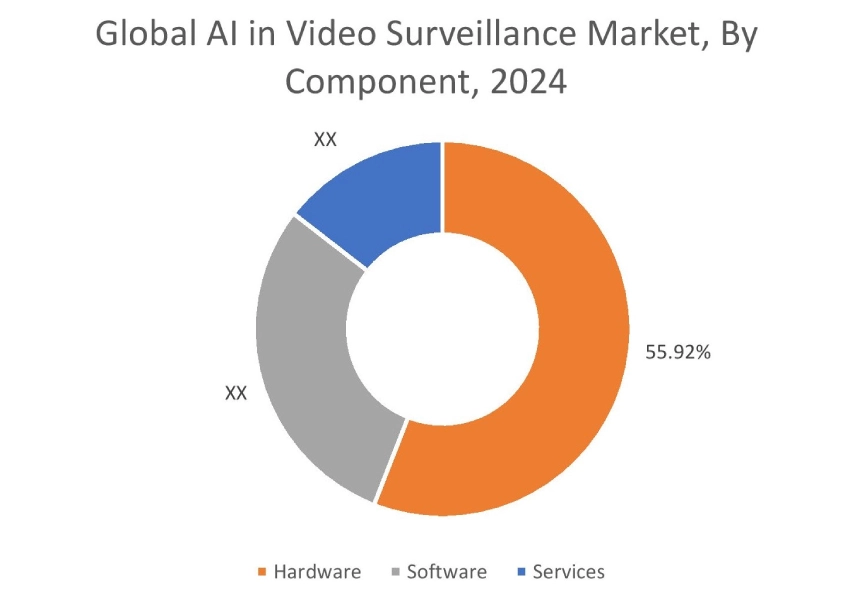
Regional Analysis:
The regions covered are North America, Europe, Asia Pacific, Middle East and Africa, and Latin America.
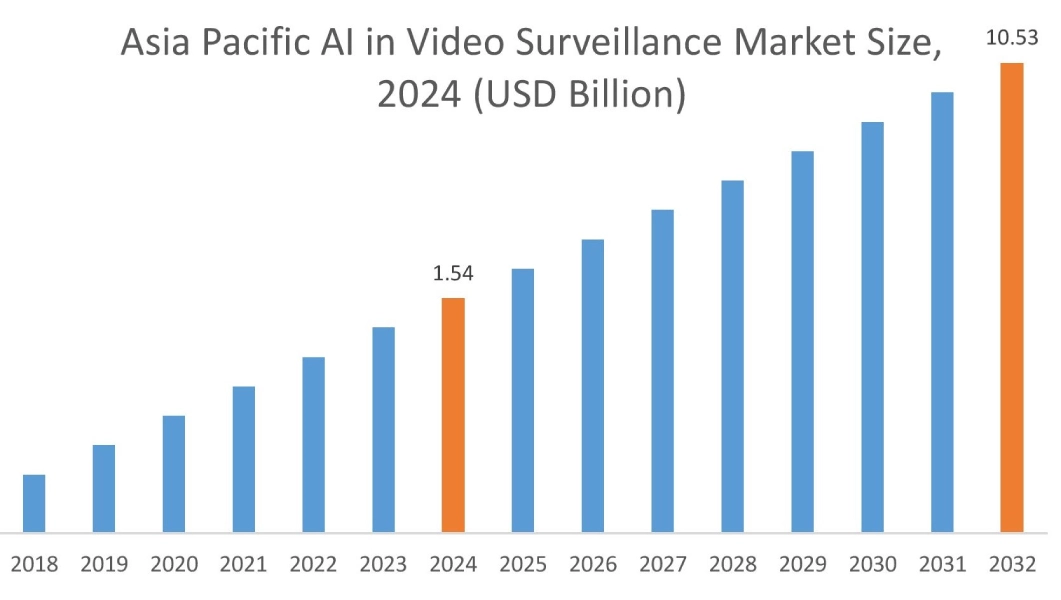
Asia Pacific region was valued at USD 1.54 Billion in 2024. Moreover, it is projected to grow by USD 2.03 Billion in 2025 and reach over USD 10.53 Billion by 2032. Out of this, China accounted for the maximum revenue share of 36.54%. As per the AI in video surveillance market analysis, the adoption of AI-based video surveillance in the Asia-Pacific region is primarily driven by the rising government initiatives for smart cities and growing retail, transportation, healthcare, and BFSI sectors among others. Additionally, the growing retail sector and increasing adoption of AI-based video surveillance among retail enterprises for facilitating real-time monitoring and surveillance along with streamlining retail operations are further accelerating the AI in video surveillance market expansion.
- For instance, according to the India Brand Equity Foundation, the retail sector in India was valued at USD 1,200 billion in 2023, and it is projected to grow up to USD 2,500 billion by 2035. The aforementioned factors are anticipated to drive market growth in the Asia-Pacific region during the forecast period.
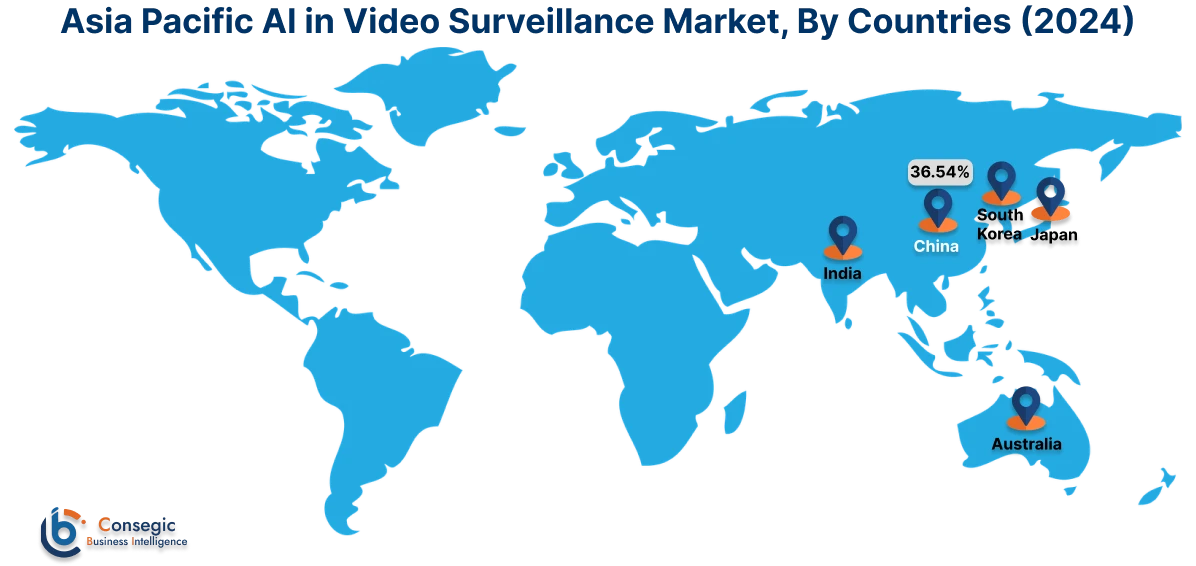
North America is estimated to reach over USD 11.83 Billion by 2032 from a value of USD 1.79 Billion in 2024 and is projected to grow by USD 2.35 Billion in 2025. In North America, the growth of the AI in video surveillance industry is driven by growing investments in banking, government & defense, retail, intelligent transportation, and industrial sectors. Moreover, the increasing adoption of AI-based video surveillance in the banking sector for monitoring employee interactions, checking workflow efficiency, and maintaining improved security and operational efficiency is further contributing to the AI in video surveillance market demand in the region.
- For instance, according to the Federal Reserve Board, there are approximately 2,160 large commercial banks in the United States as of March 2025. These banks have consolidated assets of USD 300 million or more, with several branches in the U.S as well as other countries. Consequently, the above factors are further driving the market in North America.
Additionally, the regional analysis depicts that the growing healthcare, banking, defense, and other sectors and increasing adoption of CCTV cameras for surveillance purposes are driving the AI in video surveillance market demand in Europe. Further, as per the market analysis, the market in Latin America, Middle East, and African regions is expected to grow at a substantial rate due to several factors such as the increasing pace of industrialization, significant investments in government & defense sector, and growing need for advanced surveillance systems for improved public safety & security among others.
Top Key Players and Market Share Insights:
The global AI in video surveillance market is highly competitive with major players providing solutions to the national and international markets. Key players are adopting several strategies in research and development (R&D), product innovation, and end-user launches to hold a strong position in the AI in video surveillance market. Key players in the AI in video surveillance industry include-
- Teledyne Technologies Incorporated (U.S)
- Axis Communications AB (Sweden)
- Panasonic Corporation (Japan)
- ai (Australia)
- VIVOTEK Inc. (Taiwan)
- Honeywell International Inc. (U.S)
- Bosch Security and Safety Systems GmbH (Germany)
- Genetec Inc. (Canada)
- Huawei Technologies Co. Ltd. (China)
- NEC Corporation (Japan)
Recent Industry Developments :
Product Launch:
- In December 2024, Panasonic launched its two new innovative AI-based video surveillance solutions. The new video surveillance solutions include the X-series camera integrated with AI-based on-site learning analytics along with AI-enabled high-zoom bullet cameras that are developed to offer superior security and surveillance capabilities to the Indian market.
AI in Video Surveillance Market Report Insights :
| Report Attributes | Report Details |
| Study Timeline | 2019-2032 |
| Market Size in 2032 | USD 35.10 Billion |
| CAGR (2025-2032) | 22.4% |
| By Component |
|
| By Deployment Type |
|
| By Technology |
|
| By End Use |
|
| By Region |
|
| Key Players |
|
| North America | U.S. Canada Mexico |
| Europe | U.K. Germany France Spain Italy Russia Benelux Rest of Europe |
| APAC | China South Korea Japan India Australia ASEAN Rest of Asia-Pacific |
| Middle East and Africa | GCC Turkey South Africa Rest of MEA |
| LATAM | Brazil Argentina Chile Rest of LATAM |
| Report Coverage |
|
Key Questions Answered in the Report
How big is the AI in video surveillance market? +
The AI in video surveillance market was valued at USD 5.30 Billion in 2024 and is projected to grow to USD 35.10 Billion by 2032.
Which is the fastest-growing region in the AI in video surveillance market? +
Asia-Pacific is the region experiencing the most rapid growth in the AI in video surveillance market.
What specific segmentation details are covered in the AI in video surveillance report? +
The AI in video surveillance report includes specific segmentation details for component, deployment type, technology, end use, and region.
Who are the major players in the AI in video surveillance market? +
The key participants in the AI in video surveillance market are Teledyne Technologies Incorporated (U.S), Axis Communications AB (Sweden), Honeywell International Inc. (U.S), Bosch Security and Safety Systems GmbH (Germany), Genetec Inc. (Canada), Huawei Technologies Co. Ltd. (China), NEC Corporation (Japan), Panasonic Corporation (Japan), Sensen.ai (Australia), VIVOTEK Inc. (Taiwan), and others.
